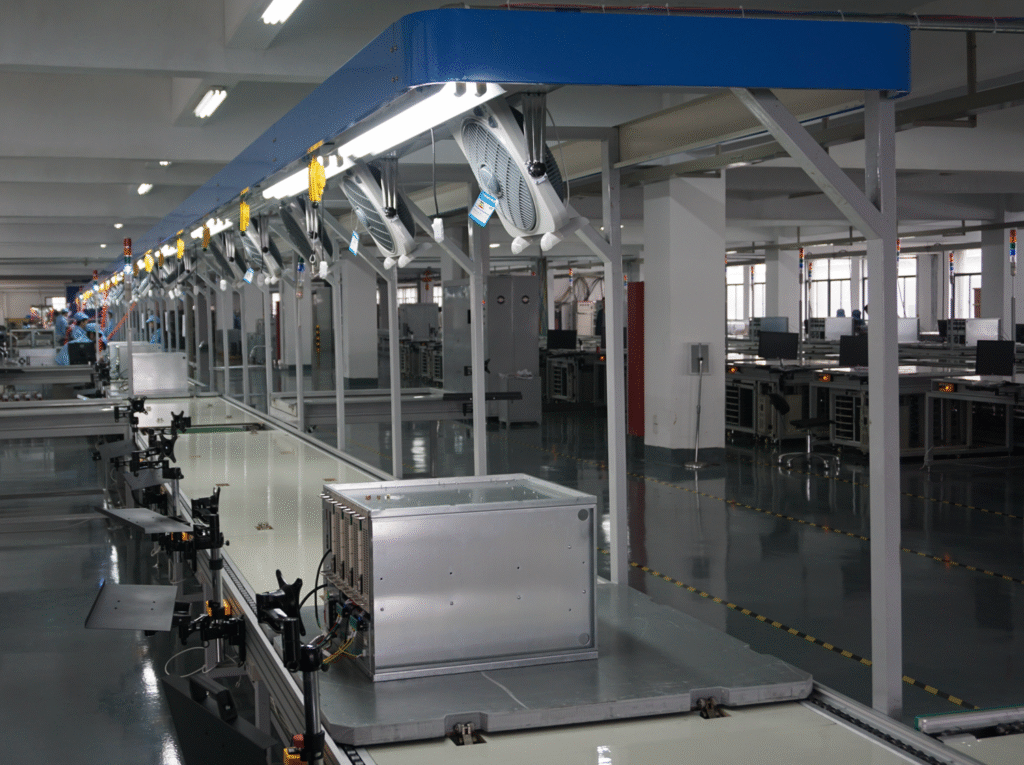CAD drawings of aluminum alloy profiles for double-speed chain conveyor lines
The double-speed chain conveyor is a common industrial automation conveying equipment.

Structure Composition
- Frame: It is the basic supporting structure of the conveyor line, usually made of steel welding, with high strength and stability, capable of bearing the weight of the conveyed materials and the operating load of the equipment itself. Its shape and size are designed according to the actual conveying process requirements, with various layout forms such as straight-line, L-shaped, and U-shaped.
- Double-speed Chain: It is the core component of the conveyor line, consisting of a series of interlocking chains, with workpiece carriers installed on the chains. The running speed of the double-speed chain can be adjusted through the motor and reducer. Its unique structural design enables the materials to be conveyed at double speed, that is, the speed of the workpiece carrier driven by the chain is twice the speed of the chain itself, thereby improving the conveying efficiency of the materials.
- Drive Unit: It mainly includes a motor, reducer, and transmission mechanism. The motor provides power for the conveyor line. The reducer reduces the high speed of the motor to meet the running speed requirements of the double-speed chain. The transmission mechanism usually adopts gear transmission or chain transmission, etc., to transmit the power of the motor to the double-speed chain to drive its operation.
- Tensioning Device: It is used to adjust the tension of the double-speed chain to ensure that the chain maintains an appropriate tension during operation, avoiding problems such as unstable operation or chain disengagement caused by chain slack. The tensioning device generally adjusts the tension of the chain through springs, screws, and other mechanisms.
- Support Device: Installed on the frame, it is used to support the double-speed chain and keep it on the correct running track. It usually consists of a series of support wheels. The support wheels are in contact with the double-speed chain, playing the role of supporting and guiding the chain, reducing the friction and wear of the chain during operation.
Working Principle
When the motor of the drive unit is started, the power is transmitted to the double-speed chain through the reducer and transmission mechanism, driving the double-speed chain to start running. The workpiece carriers on the double-speed chain move with the chain, conveying the materials placed on the workpiece carriers from one end of the conveyor line to the other. Due to the special structure of the double-speed chain, the workpiece carrier can run at double speed under the drive of the chain, that is, the speed of the workpiece carrier is twice the speed of the chain. In this way, the materials can be conveyed to a farther distance in the same amount of time, thus improving the conveying efficiency. During the conveying process, the support device supports and guides the double-speed chain to ensure its smooth operation, while the tensioning device adjusts the tension of the chain in real time to ensure the normal operation of the chain.
Application Scenarios
- Electronics Industry: In the production process of electronic products, such as the assembly of mobile phones and computer motherboards, the double-speed chain conveyor can be used to convey electronic components from one workstation to the next, achieving automated production and improving production efficiency and product quality.
- Automotive Manufacturing Industry: It is used in the assembly lines of automotive components, such as engines and transmissions, to accurately and quickly convey components to various assembly stations, meeting the high efficiency and high precision requirements of the automotive manufacturing industry.
- Appliance Industry: In the production of home appliances, such as refrigerators, washing machines, and air conditioners, the double-speed chain conveyor can convey various components and semi-finished products to the corresponding assembly links, improving production efficiency and reducing labor costs.
- Logistics and Warehousing Industry: It can be used in logistics warehouses for goods sorting and conveying, conveying goods from the storage area to the sorting area or packaging area, improving the efficiency and accuracy of logistics operations.
Advantages and Features
- Efficient Conveying: The double-speed running characteristic of the double-speed chain enables faster material conveying, greatly improving production efficiency and allowing more materials to be conveyed in a unit of time to meet the needs of large-scale production.
- Stable and Reliable: The overall machine structure is reasonably designed, made of high-quality steel and components, with high strength and stability, capable of long-term stable operation, with low failure rate, reducing the time and cost of equipment maintenance and repair.
- High Flexibility: The layout and length of the conveyor line can be flexibly designed according to different production processes and site conditions, adapting to various complex working environments and production processes, achieving efficient material conveying and automated production.
- Easy Maintenance: The structure of the equipment is relatively simple, with tight connections and cooperation between various components, which is convenient for daily maintenance and maintenance. In addition, the components have good interchangeability and universality, making it more convenient and quick to replace damaged parts, reducing the cost and difficulty of equipment maintenance and repair.
